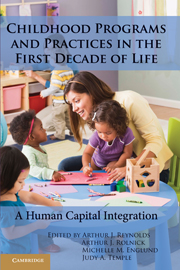Book contents
- Frontmatter
- Contents
- Contributors
- Foreword: The Essential Role of Youth Development by Robert H. Bruininks
- Acknowledgments
- 1 Early Childhood Development and Human Capital
- PART I PRENATAL AND INFANT PROGRAMS
- PART II PRESCHOOL EDUCATION
- 6 Project Head Start: Quality and Links to Child Outcomes
- 7 The Challenge of the HighScope Perry Preschool Study
- 8 Impacts and Implications of the Child-Parent Center Preschool Program
- 9 Small Miracles in Tulsa: The Effects of Universal Pre-K on Cognitive Development
- 10 Lessons From the Evaluation of the Great Start Readiness Program (GSRP): A Longitudinal Evaluation
- 11 Abbott Preschool Program Longitudinal Effects Study Year One Findings
- Commentary: Are We Promising Too Much for Preschool Education Programs?
- PART III KINDERGARTEN AND EARLY SCHOOL-AGE SERVICES AND PRACTICES
- PART IV ECONOMIC SYNTHESES OF EARLY CHILDHOOD INVESTMENTS
- Appendix Question-and-Answer Sessions
- Name Index
- Subject Index
- References
6 - Project Head Start: Quality and Links to Child Outcomes
Published online by Cambridge University Press: 05 June 2012
- Frontmatter
- Contents
- Contributors
- Foreword: The Essential Role of Youth Development by Robert H. Bruininks
- Acknowledgments
- 1 Early Childhood Development and Human Capital
- PART I PRENATAL AND INFANT PROGRAMS
- PART II PRESCHOOL EDUCATION
- 6 Project Head Start: Quality and Links to Child Outcomes
- 7 The Challenge of the HighScope Perry Preschool Study
- 8 Impacts and Implications of the Child-Parent Center Preschool Program
- 9 Small Miracles in Tulsa: The Effects of Universal Pre-K on Cognitive Development
- 10 Lessons From the Evaluation of the Great Start Readiness Program (GSRP): A Longitudinal Evaluation
- 11 Abbott Preschool Program Longitudinal Effects Study Year One Findings
- Commentary: Are We Promising Too Much for Preschool Education Programs?
- PART III KINDERGARTEN AND EARLY SCHOOL-AGE SERVICES AND PRACTICES
- PART IV ECONOMIC SYNTHESES OF EARLY CHILDHOOD INVESTMENTS
- Appendix Question-and-Answer Sessions
- Name Index
- Subject Index
- References
Summary
INTRODUCTION
Head Start began in 1965 as part of the Johnson administration's War on Poverty efforts to help reduce the gap in achievement between children from low-income families and their more advantaged peers. When Head Start began in 1965, publicly funded early childhood education programs for children 3–5 years of age were not widely available, especially not for families living in poverty. Head Start became one of the most widely recognized and popular federal programs. Today, it consists of two programs: Head Start and Early Head Start, which was established during the 1994 Head Start reauthorization (see Chapter 5). In fiscal year 2008, Head Start was allocated approximately $6.9 billion, of which $6.2 billion funded 1,905 programs providing services to 976,150 children and their families, according to the latest Program Information Record (PIR) data from the 2006–2007 fiscal year. Head Start is funded through a combination of federal funds given directly to local grantees (80%) plus a local match or in-kind contributions (the remaining 20%). In-kind contributions may be in the form of monetary contributions, donations of goods or services, or volunteer hours. Grantees receiving funds to operate Head Start programs tend to be community action agencies (32%), public/private school systems (17%), or private/public nonprofits, such as churches and nonprofit hospitals (37%).
Whether Head Start is able to reduce the achievement gap and indeed whether it “works” has been a hotly debated topic since its inception, and legislative pressures to demonstrate program performance and accountability are increasing.
Information
- Type
- Chapter
- Information
- Childhood Programs and Practices in the First Decade of LifeA Human Capital Integration, pp. 121 - 156Publisher: Cambridge University PressPrint publication year: 2010
References
Accessibility standard: Unknown
Why this information is here
This section outlines the accessibility features of this content - including support for screen readers, full keyboard navigation and high-contrast display options. This may not be relevant for you.Accessibility Information
- 1
- Cited by
